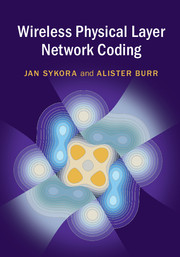Book contents
- Frontmatter
- Contents
- Preface
- Mathematical Symbols
- Abbreviations
- Part I Motivation and Gentle Introduction
- Part II Fundamental Principles of WPNC
- 3 Fundamental Principles and System Model
- 4 Components of WPNC
- 5 WPNC in Cloud Communications
- Part III Design of Source, Relay, and Destination Strategies
- Appendix A Background Theory and Selected Fundamentals
- References
- Index
4 - Components of WPNC
from Part II - Fundamental Principles of WPNC
Published online by Cambridge University Press: 01 February 2018
- Frontmatter
- Contents
- Preface
- Mathematical Symbols
- Abbreviations
- Part I Motivation and Gentle Introduction
- Part II Fundamental Principles of WPNC
- 3 Fundamental Principles and System Model
- 4 Components of WPNC
- 5 WPNC in Cloud Communications
- Part III Design of Source, Relay, and Destination Strategies
- Appendix A Background Theory and Selected Fundamentals
- References
- Index
Summary
Introduction
This chapter still contains general material on the processes carried out at each node, especially the relays, but it goes deeper into the details of each WPNC component, as previously defined in Chapter 3. It defines design criteria and models, expanding on Chapter 3, which gives only definitions and classifications. On the other hand, more advanced material and particular methods of constructing these components will be described later, in Part III.
The topics are structured according to the division: (a) MAC front-end Rx processing, (b) relay HNC map and processing operation, and (c) BC back-end Tx processing. Note that source and destination nodes are special cases with BC back-end only and MAC front-end only processing and a singular form of HNC map and processing operation. In the sense of the hierarchical principle explained in Chapter 3, we focus here on direct local neighborhood of the node. Global whole WPNC cloud aspects are treated in Chapter 5.
We start with the description of the back-end processing, since it determines the transmitted signals. Then we discuss demodulation and decoding techniques associated with the front-end processing. Both front-end and back-end processing assume that the HNC map is given. Particular aspects related to the HNC map are discussed at the end.
Network Coded Modulation
Multi-source Network Structure Aware Constellation Space Codebook
Network Coded Modulation (NCM) is the name for a multi-source network structure aware signal space code. NCM is an implementation of the back-end node strategy that is suited for maximal a priori knowledge utilization of WPNC network structure. Such back-end strategy should fulfill the following.
(1) WPNC operates in the wireless domain and the information must be encoded by the channel coding that fully respects that the encoded transmitted symbols are the signal space constellation symbols. NCM is a channel coding that must provide forward error correction/protection capabilities. This is reflected by “coded modulation” in the name, and it is quite obvious and not much different from the classical single-user systems.
(2) NCM must be network structure aware and must respect it, hence the name “network coded modulation.” NCM must “see around the corner” in the network. Clearly, decoding individual source component data at the node that receives NCM multiple signals might not be the optimal strategy.
Information
- Type
- Chapter
- Information
- Wireless Physical Layer Network Coding , pp. 67 - 111Publisher: Cambridge University PressPrint publication year: 2018
